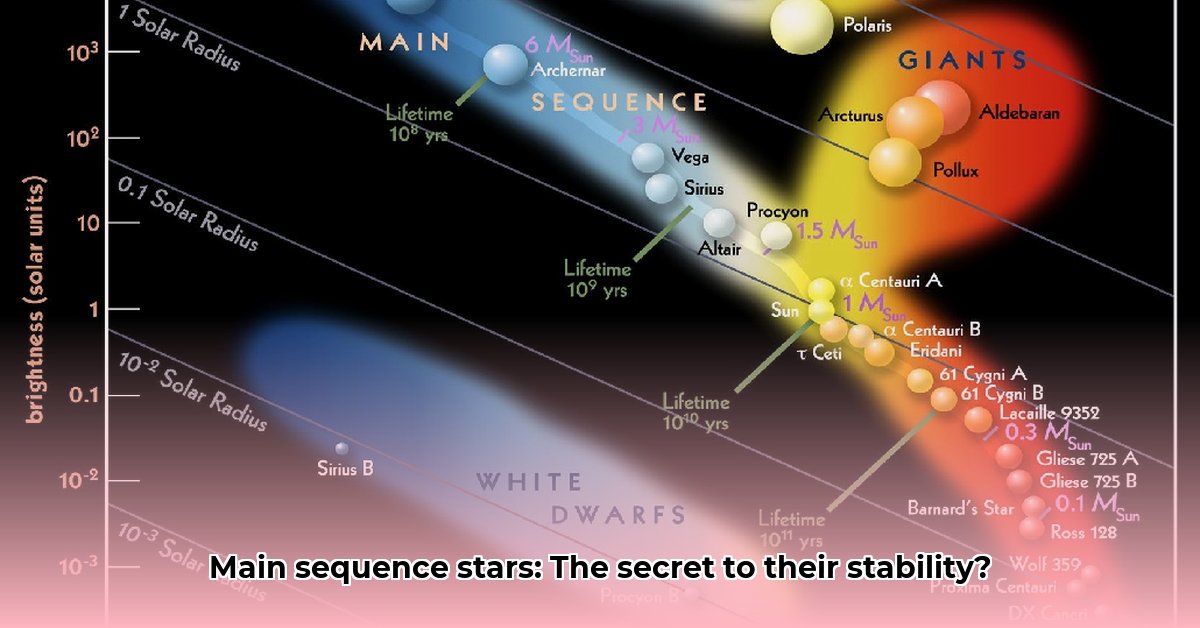Have you ever gazed at a star and marveled at its seemingly perpetual glow? For the majority of their existence, stars maintain a remarkably stable state, a testament to a delicate equilibrium between opposing forces. Imagine a seesaw perfectly balanced: gravity relentlessly pulling inward, countered by the immense pressure emanating from the star’s nuclear core. This article delves into this cosmic balancing act, exploring how stars sustain their size, luminosity, and temperature for eons, and the consequences when this equilibrium falters. Learn more about protostars to understand this process better.
Understanding Main-Sequence Star Stability and the Stellar Lifecycle
Our Sun, a seemingly constant presence in the sky, is actually a colossal sphere of plasma locked in an exquisite balancing act. Understanding what a main-sequence star maintains during its stable phase is crucial for grasping the lives of stars in general. So, what key aspects does a main-sequence star preserve throughout its remarkably long and consistent period? Let’s explore the fascinating physics that govern stellar equilibrium and discuss crucial concepts such as hydrostatic equilibrium, energy production, and energy transport.
The Amazing Balancing Act: Hydrostatic Equilibrium Explained
Picture a fully inflated balloon. The air pressure inside exerts an outward force against the elastic skin. A star mirrors this, but instead of air, it’s an immense quantity of intensely hot plasma, and instead of rubber, it’s gravity—an incredibly powerful force. A main-sequence star sustains a critical balance known as hydrostatic equilibrium, a continuous “tug-of-war” between gravity’s relentless inward crush and the outward pressure generated by nuclear fusion within the star’s core. This pressure, akin to the air within the balloon, precisely counteracts gravity, preventing the star from collapsing. This phenomenal equilibrium can last for millions, even billions, of years. This balance ensures the star maintains a relatively constant size and shape. What external and internal factors affect stellar equilibrium?
The Star’s Power Plant: Nuclear Fusion and Energy Transport Dynamics
What powers this cosmic struggle? The answer lies in nuclear fusion, a process where lighter atomic nuclei, primarily hydrogen, are forced together under immense pressure and temperature to form heavier nuclei, such as helium, releasing a tremendous amount of energy in the process. Consider it a gigantic nuclear power plant that consistently keeps the light shining. This energy doesn’t remain stagnant; it must escape the star’s core and reach the surface to be radiated into space. Initially, energy travels outwards primarily via radiation in the deep inner core, similar to heat transfer through a thick iron plate. Photons, generated by fusion, are constantly absorbed and re-emitted by the dense plasma, slowly diffusing outwards. Subsequently, closer to the surface where the gas is cooler and less dense, convection dominates. This involves vast churning of hot gas, with heated plasma bubbles rising and transporting energy to the surface, much like boiling water in a pot. This dual process is vital for maintaining the star’s stability as it regulates the outflow of energy, preventing energy from building up in the core and disrupting hydrostatic equilibrium. How do size and location of convective zones and radiative zones impact energy transport?
Steady as She Goes: Maintaining Size, Luminosity, and Temperature Consistency
Besides this delicate balance, what else does a main-sequence star maintain? It sustains a surprisingly consistent size, luminosity (brightness), and temperature. This stability arises because the energy generated in the core precisely matches the rate at which energy radiates from the surface into space. This exact match prevents the star from collapsing under its own weight or uncontrollably expanding due to internal pressure buildup. It’s a self-regulating system of remarkable precision, a finely tuned cosmic thermostat. A main-sequence star also maintains a consistent spectral type, which is directly related to its surface temperature and color. Does the presence of heavy elements (metallicity) in a star’s atmosphere affect its overall surface temperature and luminosity?
The Subtle Influences: Factors Affecting Stellar Equilibrium
While main-sequence stars exhibit considerable stability, they are not entirely static. Several subtle factors can influence their equilibrium. A star’s mass is the most significant factor. More massive stars have a stronger gravitational pull, requiring a higher core temperature and rate of fusion to maintain hydrostatic equilibrium. This leads to a much higher luminosity and shorter lifespan compared to less massive stars. Their more vigorous “tug-of-war” results in higher surface temperatures and brighter light output. A star’s initial composition also plays a role, with minor changes in elemental proportions slightly affecting fusion rates and energy transport efficiencies, causing small adjustments in size and brightness. The age of a star subtly affects its luminosity as the composition of its core changes due to the ongoing fusion of hydrogen into helium. These can be viewed as minor adjustments to the cosmic tug-of-war that generally don’t disrupt the equilibrium during the main sequence. How does a star’s initial mass influence not only its stability but also its eventual fate?
The End of the Main Sequence: When the Balance Breaks Down
The main-sequence phase is finite. Eventually, the star’s core hydrogen fuel is depleted, causing hydrostatic equilibrium to break down. The core contracts under gravity, increasing in temperature and density. In response, the outer layers of the star expand and cool, transforming the star into a red giant or supergiant. The details vary based on the star’s initial mass, setting the stage for its later life as a white dwarf, neutron star, or black hole. This marks the end of the main sequence, initiating a new chapter in the star’s life story, and begs the question, does a dying star maintain gravitational equilibrium even as it evolves off the main sequence?
Ongoing Research and Uncertainties
Our comprehension of stellar evolution continues to advance as scientists refine models of stellar interiors using advanced computer simulations and observations from space-based telescopes and observatories such as the James Webb Space Telescope. These sophisticated models incorporate complex physics, including nuclear reactions, radiative transfer, and convection, to accurately simulate the behavior of stars. While our current understanding provides a comprehensive picture, uncertainties persist, especially regarding processes within the cores of massive stars and the precise mechanisms of stellar mass loss. Ongoing research explores these areas, enhancing our understanding of the magnificent lives and deaths of stars and their impact on the evolution of galaxies.
- Adult Voice Lessons Transform Your Singing and Build Confidence - January 7, 2026
- Vocal Performance Artistry Requires Unmatched Control and Emotional Depth - January 6, 2026
- Understanding Acting Theories and Diverse Methods for Actors - January 5, 2026










